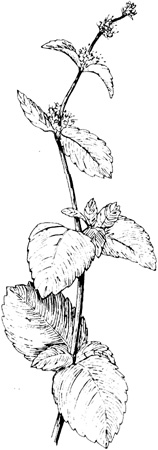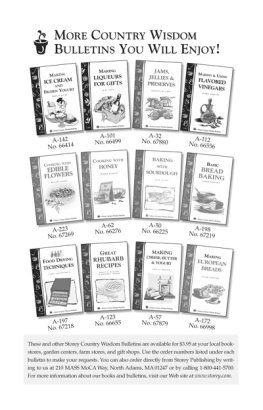Growing and Cooking with Mint
by Glenn Andrews
Mint Lore
Mint is one of the great herbs, one its hard to imagine getting along without. Throughout the centuries, mint has been used medicinally for indigestion and as a cure for everything from dogbite to bad dispositions. Even today, we taste it (and probably feel its beneficial effect) in cough drops, antacids, mouthwashes, and a wide range of other products.
Before the advent of finished floors, it was customary to strew herbs on the dirt floors of houses. Just lying there, the herbs gave off fragrance, but when they were stepped on, a strong and lovely aroma came forth. Many different herbs were used for this purpose, but none more so, or to greater effect, than mint. Its rather a shame weve let this practice go. Imagine how pleasant it would be to come home from a hard days work, open the door, walk in, and set off a cloud of the sweet scent of mint!
Today we do put mint in sweet-scented potpourris. Youll find a recipe on page 6.
But people in widely scattered parts of the world (Thailand, North Africa, England, and Greece, for instance) have long since discovered the best use of all for mint as a special flavoring in cooking.
If you grew up in the United States, you may have encountered mint only in the form of the bright green, artificially colored mint jelly often served with lamb. Or perhaps your mother always stuck a sprig of mint into your iced tea. (My own mother always whacked the sprig across her wrist to release more of the mints flavor first.) If so, then youve missed many starring roles for mint, and youre in for a tremendous treat. Try the recipes in this bulletin and discover the joys of mint.
But first, you need to know some of the varieties of mint available, and where and how to grow them. Also, its important to know how to preserve some of your crop for year-round use, so youll always have some on hand.
Then on to the recipes!
The Many Varieties of Mint
The Mint Family includes basil, summer savory, and marjoram, but the ones were concerned with here are the actual Mentha varieties, including pennyroyal.
Mint is a hardy perennial, dying back in the winter in cold climates and emerging in the spring. It is best propagated by cuttings or plants, not seeds. (It will root readily in water, though not if your water is heavily treated with chemicals.) Some seed catalogs offer mint seed, but often with the warning that mints grown from seed are not uniform and that their flavor will range from spearmint to peppermint.
At the end of this bulletin, youll find a listing of several sources for mint plants, including most of the unusual varieties, and one source for seeds.
The two most popular mints are spearmint and peppermint, but there are many other varieties. Perhaps you can find a friend who will be happy to give you plants or cuttings, or you may find just what you want at a local nursery. In either case, you might want to break off a leaf, scrunch it up in your fingers and smell it, then take a taste. Youll know right away whether youre going to like it. (Ive been doing this for years and have never been reprimanded. But then, Ive never been caught!) Here are some of the varieties that exist:
Spearmint(Mentha spicata). The old favorite of cooks around the world. If you can only have one mint, I strongly recommend that you choose either spearmint or applemint, which has a similar taste. This is not just a matter of personal taste; spearmint is milder than peppermint and seems to lend itself better to many sorts of dishes. Its leaves are larger, too, which comes in handy in cooking, and the plants thrive almost anywhere. The plant has bright green leaves, which are shaped like spearheads. It grows to 2 feet, sometimes higher.
An interesting variety is Mentha spicata Chewing gum, which has a strong spearmint flavor and mahogany foliage, and the scent of chewing gum.

Spearmint

Peppermint
Peppermint(Mentha x piperita). This mint features purple stems with dark green leaves, and is great for tea and for medicinal uses. It does have one problem: it should be moved every 2 to 3 years. Some cooks find it a bit harsh for culinary use. This plant typically grows to 2 feet.
Applemint(Mentha rotundifolia). This is every Grandmas favorite mint. It has excellent flavor, but wilts quickly after picking. The light green leaves are somewhat woolly in appearance and the plant typically grows to 3 feet.
English applemint(Mentha suaveolens). This variety is easily grown (even more so than most mints), and doesnt need as much moisture as others. It is very good for all sorts of cooking and its light green foliage is good for making candied leaves. It grows to 2 feet in height.
Pineapplemint(Mentha suaveolens Variegata). This variety has a pleasant aroma similar to a ripe pineapple, and is nice in iced tea. The plants green leaves are edged with white, and it typically grows to 2 feet in height.
Orangemint (Mentha x piperita Citrata). Also known as bergamot mint and Eau de Cologne mint, or Lavendar mint, this mint seems to vary in scent from plant to plant, hence the multiplicity of names. It is especially enjoyable in teas (hot or iced), punches, potpourris, and salads, and is the choice mint for Mint Juleps (see page 29). The plant has dark green leaves, and grows to 2 feet tall.

Orangemint
Chocolate mint(Mentha x piperita Chocolate). The aroma is as evocative of chocolate-covered mint patties as the name. Usually used in conjunction with sugar in desserts and ices, the plant has dark green leaves and grows to 18 inches in height.
Variegated Scotch mint(Mentha x gentilis Variegata). This plant has a mild spearmint taste. Its appeal is in its coloring: striking gold and green variegated leaves. It grows to 1 foot tall.
Corsican mint(Mentha requiennii). This mint makes a superb and extremely aromatic ground cover, especially in moist shade, where many plants fail. It has tiny leaves, and the plant itself is extremely small it grows to about 1 inch in height. This mint is not reliably hardy in cold climates.
Horsemint(Mentha longifolia). This is one of the wild mints. Its flavor and aroma are between spearmint and peppermint. The plant is covered with fine white hairs, and grows to 2 feet tall.
Native mint(Mentha arvensis). This plant is the original wild mint native to the northern reaches of North America. It is suitable for any mint use. This mint is easy to spot because its tiny lavender flowers dont form on stalks, rather they grow in little circles around the stem just above the spot where each pair of leaves emerges. The plant grows to 2 feet.
Mint Potpourri
A potpourri of any sort will perfume the air and add its own sort of joy to your life. The ones you make from herbs and flowers you have grown yourself are especially effective as well as rewarding.





